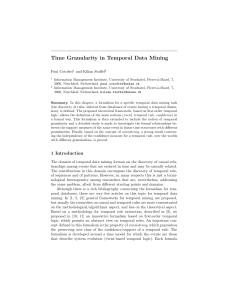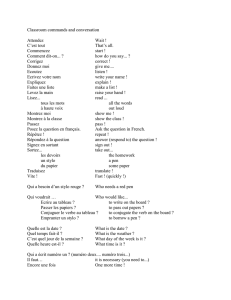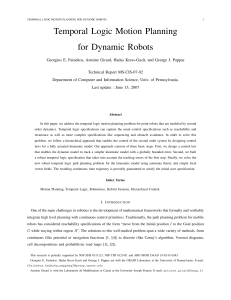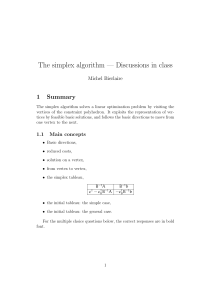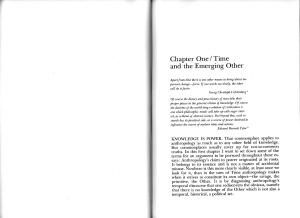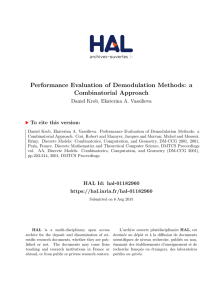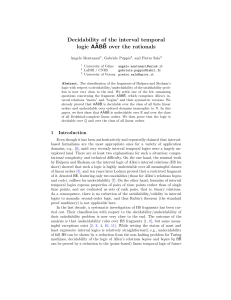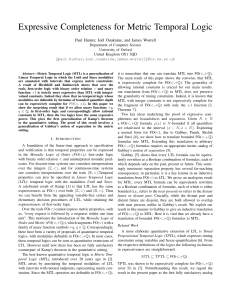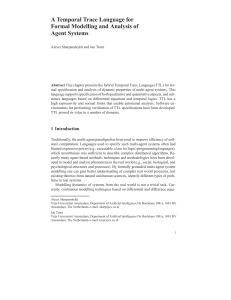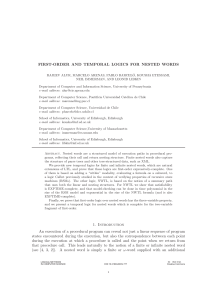Open access
publicité
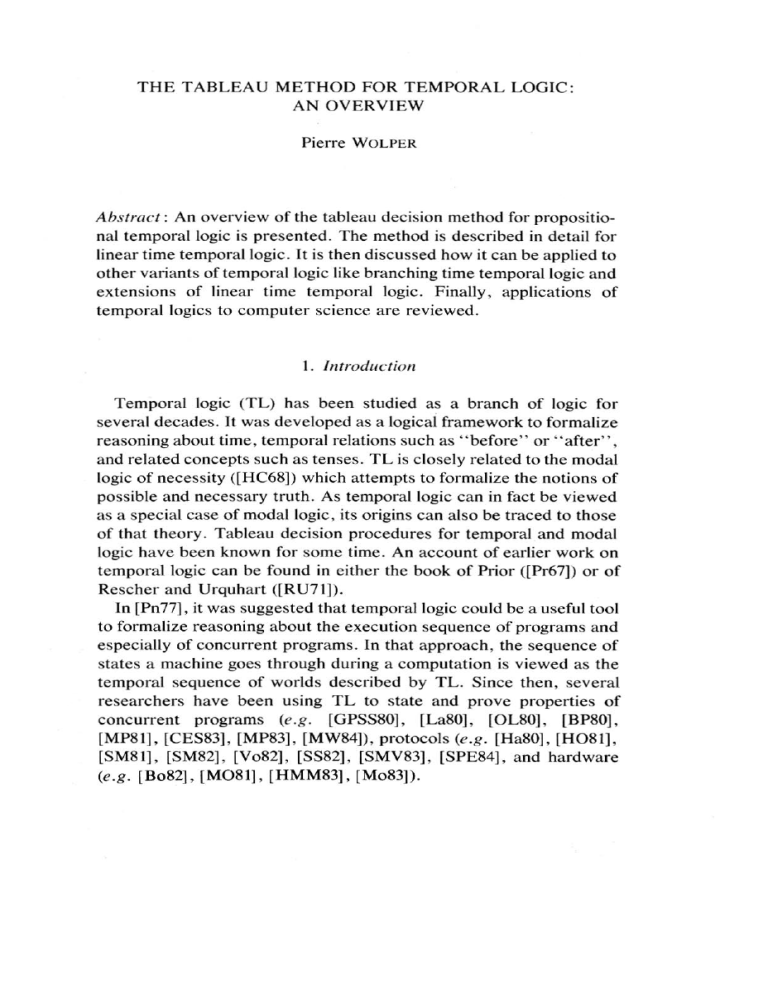
THE TABLEAU ME THOD FOR TEMPORAL LOGIC:
AN OVERVIEW
Pierre WOLPER
Abstract: An overview of the tableau decision method for propositional temporal logic is presented. The method is described in detail for
linear time temporal logic. It is then discussed how it can be applied to
other variants of temporal logic like branching time temporal logic and
extensions o f linear time temporal logic. Finally, applications o f
temporal logics to computer science are reviewed.
I. I nt roduc t ion
Temporal logic (TL ) has been studied as a branch o f logic fo r
several decades. It was developed as a logical framework to formalize
reasoning about time, temporal relations such as " b e fo re
— related
and
o r " concepts
a f t esuch
r " as
, tenses. TL is closely related to the modal
logic of necessity ([HC68]) which attempts to formalize the notions of
possible and necessary truth. As temporal logic can in fact be viewed
as a special case of modal logic, its origins can also be traced to those
of that theory. Tableau decision procedures for temporal and modal
logic have been known for some time. An account of earlier work on
temporal logic can be found in either the book of Prior ([Pr67]) or of
Rescher and Urquhart ([RU711).
In [P677], it was suggested that temporal logic could be a useful tool
to formalize reasoning about the execution sequence of programs and
especially of concurrent programs. In that approach, the sequence of
states a machine goes through during a computation is viewed as the
temporal sequence o f worlds described by TL . Since then, several
researchers have been using T L to state and prove properties o f
concurrent programs (e .g . [GPSS801, [La80], [ 0 L 8 0 ] , [BP80],
[MP8 I], [CES831, [MP83], [MW84]), protocols (e.g. [Ha80], [H081],
[SM81], [SM82], [Vo82], [SS82], [SMV83], [SPE841, and hardware
(e.g. [Bo821 , [M081], [HMM83], [Mo831).
120
P
.
WOLPER
In this paper, we first define the propositional version of linear time
temporal logic. We then describe the tableau decision procedure for
PTL. We also review other variants o f temporal logics and state
results about their decision problems. And finally, we discuss the use
of temporal logic in computer science.
2. Propositional Temporal Logic
We define here the propositional version of temporal logic (PTL).
We have chosen one of the most common versions appearing in the
computer science literature. In contrast to the temporal logics studied
in philosophical logic it contains only temporal operators dealing with
the "future" and no operators concerning the "past".
Syntax: PTL formulas are built from
• A set Y of atomic propositions: p
•l Boolean connectives: A,
•, Temporal
p
operators: 0 ("next"), 0 ("eventually"),
U ("until'').
2
, p rules are:
The formation
3
•, A n atomic proposition p e Y is a formula.
• Iff
t
Ah, O A , 0 1
a n
. as an abbreviation for --1 0 W e also use V
We use El ("always")
d 1
1 , f i 1 1 .and
1 parentheses to resolve ambiand D .as the usual abbreviations,
guities.
.
2
Semantics: A structure
2 • f o r a P TL formula (with set 6
a
4propositions)
o f
a tis oa triple
m i .33
c
r
7 = ( S ,
e• S is a finite or enumerable set of states.
N
,
f
a
) • N : (5' —)S ) is a total successor function that for each state
o
w h e gives
r e a unique next state.
r
• a : (S—>2) assigns truth values to the atomic propositions of
m
the language in each state.
u
l
a
s
,
s
o
a
r
e
THE TA B LE A U METHO D
1
2
1
For a structure vl and a state s S we have
(71, , $ )p i f f p En(s)
(d ,$) A f
(cl
i
f
n o t (cl,$)
2
(cl,
i f s)f O f i f f (c V , N ( s ) )
., $ )
In the following
definitions, we denote by N
f f ,
sequence
e
( s ) ta h e
i t '
s , N (s), N(N(s)), N(N(N(s))),
s t n
a t e
i
n
d
of
successsors
of
a
state
s.
t
h
e
ç 1
(91i,$)<>1'
iff ( 0 )“2 1 , Nl(s ))
,
.$ , s)) u f 2 i f f ( 3 i 0 )((iz i, N ( s ) ) f f
(5zi
/f ) A
2
j (0 < i D ( , Ni ( s ) ) 1
7
.
An interpretation
J = (ci „v
1
2 state s
anoinitial
))
satisfies
o ) e f So a.r formulaf
P T iffL 1
.determines
W
5 cV ,eos n as sequence
i s t s
0w o •i l fl
o= s
fs .a a S i n c e
o
o satisfies a formula" instead of "the
awe
y swilltnoften
r say
u "the
c sequence
t
, N
a formula". The satisfiability problem fo r
itinterpretation
u
n ht r e e r .p
d/ satisfies
r e
(s
taPTL
aa is,
t given
i o nan formulai', to determine if there is some interpretation
0
that
satisfies
f(i.e., a model off). In the next section, we describe the
fa d
)
,
for
untableau
n method
i
q the satisfiability problem of PTL.
A
ui n et e l
y
P
rExaniples:
p r e
( s
t a t i
o
oI) The
n formula
) ,
J
N
=
3 by all sequences in which p is true in the first state.
(is satisfied
3
( s
72) The1 formula
0
,
s L fp O c . i)
) ,
0
)is satisfied by all sequences where each state in which p is true is
followed by a state in which q is true.
122
P
.
WOLPER
3) The formula
Dp D ( - - - q Ur))
is satisfied by all sequences where if p is true in a given state, then,
from the next state on, q is always false until the first state where r is
true.
4) The formula
▪ Op
is satisfied by all sequences in which p is true infinitely often.
5) The formula
Dp A 0 - p
is not satisfied by any sequence.
6) The formula
Op ( — p p )
is satisfied by all sequences (it is valid).
3. The Tableau fil' ethod fin
- P H .
The tableau method foi
P T L
ilogic
s (see [Sm681). Boolean connectives are handled
for- propositional
a
n
exactly a s f o r propositional logic and temporal connectives a re
e x by
t decomposing
e n s i
handled
them into a requirement on the "current
o n
state
decomposition
f of the temporal connectives makes the tableau into a
—o
state
t
by
state
h
search for a model of the formula being considered. The
a n
decomposition
rules f o r the temporal operators are based on the
d e
following
a identities:
b
l
a t
a
u
r e
=./. V 0 O f
(
I)
e
q m
uf2
(1 t
o
d
u hi
.
Given
r e that decomposing formulas using identities (1-2) does not make
2 vthe tableau might be infinite. However, we will insure
them
smaller,
m
that
V I is f i
e the tableau
n
labeled
i
t
e
by
b
y same set of formulas. Note that in the tableau method
n t
Athe
io d e n 0t i f y
i n g
n
V e
t"
h
n
o I d
t
e
s U .
h
o
f 2
e
fr
) )
te
h•
e
s
THE TA B LE A U ME THO D
1
2
3
for propositional logic this is not necessary as the tableau is always a
finite tree. Another difference is that obtaining a tableau with no
propositional inconsistencies for a formulaf is not a guarantee thatf is
satisfiable. Indeed, formulas of the form O h or 1f) U1
.
eveuttlalitie,s'
might not be satisfied. The problem is that, for instance
for
21a w
formula
h i c O
hf
w
e
c a l l
t
continuously
postpone the point at wh ich f
l,ponds
i ts htosealways
a t i schoosing
f i e d the
. 0 O f disjunct in ( I). We will thus have
tto aadd
T
hbanl iextra
e sa step to the tableau method which will eliminate nodes
containing
cu o r eventualities
r e s that
- are not satisfiable.
to test a PTL formulaf for satisfiability, the tableau
r More
u precisely,
l
emethod constructs a directed graph. Each node tt o f the graph is
blabeled
a by as set of formulas T„. Initially, the graph contains exactly
one
node,
e
d labeled by t n . To describe the construction of the graph,
owe distinguish between elementary and non-elementary formulas.
nElementary formulas are those whose main connective is 0 (we call
or that are either atomic propositions or negations
(these 0-formulas)
I
of
atomic
propositions.
The construction o f the graph proceeds by
)
using
the
following
decomposition
rules which map each non-elew
i
lmentaryl formulai into a set E o f sets 5'
a1 o f lf o r m u l a s f
-1
t
f
l
li
o
- Of
{0
:
w
fl A .f2 , f 2 11
u
- A 1
s
O
. f t
› •O f — ) 1 - - , 0./11
o
2) —
0 (fl uf211
, U.f2 t f 2
>
—
(f
1
u
1
(
Ithet construction, t o avoid decomposing the same formula
During .0
O will mark the formulas to which a decomposition rule has
—
2)
twice, we
M
been applied
A I w e don't simply discard them as we will need them
—
when checking i f eventualities are satisfied). Once the graph i s
, 2we eliminate unsatisfiable nodes.
4
constructed,
The graph
,I
construction proceeds as follows:
—
11 Startv
with a node labeled by t f l where/is the formula lobe tested.
We will
1
U /call f the initial fimmtla and the corresponding node the
f.
2 1
)1
1
124
P
.
WOLPER
initial node. Then repeatedly apply steps 2) and 3). In these steps,
when we say —
c r ewe
a tmean
e
create a node if the graph does not already contain a
node
labeled by T. I f it does, we just create an edge from n to the
a
already
s o nexisting node.
2) Iof a node
n labeled by T„ contains an unmarked non-elementary
f
formula
n
o f and
d the tableau rule for f is f —›IS,1, then, for each S,,
create
a son o f n labeled by (T„ — t f l ) U S, U W I where P is f
e
marked.
n
3) Il f a a
nodebn contains only elementary and marked formulas, then
create
e
l a eson o f tt labeled b y the 0-formulas ST„ wit h th e ir
outermost
0 removed.
d
A node
b containing only elementary or marked formulas will be called
a y
s aastate will be called a pre-state.
of
t Given
the form of the tableau rules, the formulas labeling the nodes
s
u the
of
graph
are subformulas or negations of subformulas of the initial
e
t t
formula
o r such formulas preceded b y O . Th e number o f these
e o
formulas
is equal to 4/, where! is the length of the initial formula. The
.number
of nodes in the graph is then at most equal to the number of
f
sets
A f of such
o formulas, that is 2
4
n / At
point, to decide satisfiability, we have to eliminate the
r this m
.d u
unsatisfiable
l nodes of the graph. We repeatedly apply the following
three
, a rules.s
a
E l: I f a node contains both a proposition p and its negation
n
eliminate that node.
o
E2: I f all the successors o f a node have been eliminated, eliminate
d
that node.
e
E3: I f a node which is a pre-state contains a formula of the form O f
t
o rf
h
l
To
if a formula O f or f
a determine
U rule:
following
lt U f
.
2
s
iFI: ALi formula
O f o rf
ss a t i s f i a b l e ,
l L path
i. f in the tableau leading from that pre-state to a node contaio
n
e
e
ning
2
t i sthe formulah
u
s
e
is a .ht • i s f i a b s
procedure
ends after all unsatisfiable nodes have been
tt The decision
h
e
l e a
h
i
t n
e
a
i
rp rs e ts tn a t e
h
,
o
e
i
t
if
s
n
t
a h
i
THE TA B LE A U ME THO D
1
2
5
eliminated. I f the initial node has been eliminated, then the initial
formula is unsatisfiable, if not it is satisfiable.
Eximiple
Consider the formula O p A 0 — p . The tableau obtained f o r this
formula by the algorithm we have just described is the one appearing
in ligure 1.
I t O p A 0----121
2 l Op, 0 --, p
Li
p
A
0 Ep-x-,
.3 lp , 0 Op
O
—
pp
A
O p A <> i p <
4 Op * , —ip-x• x>•
p,0111p
l
--p
x
-
Op» ,
, 0 Op
A p
- 0O p0 —
p
,
k 1
6 {O p , 0 - 1 , }
4
7
t
p
,
O
l
E
p
p,0111p
1111p*,
<>-171
p, 0 Dp 1
9 1 Elp•IF.
0 —p-x-I/
0 0 --p
i
Figure I
126
P
.
WOLPER
In this tableau, the initial node is 1: the states are 4, 5.8 and 9: and
the pre-states are 1 and 6. Nodes 4 and 8, contain a proposition (p) and
its negation. they are thus unsatisfiable and are eliminated by rule El.
Node 6 is a pre-state and contains an eventuality formula (0 p ) that
is not satisfiable as there is no path leading from 6 to a node containing
rule
E2 and the formula is found to be unsatisfiable.
i
l It is easy to see that the decision procedure requires time and space
exponential
in the length I of the initial formula. Actually. it is possible
l
to
test
a
PTL
formula for satisfiability using only polynomial space.
(
The
satisfiability
problem for PTL is in fact complete in PSPACE. For
n
ao discussion of the complexity of PTL, see [SC821 and [WVS83]. The
correctness
of the tableau method we have just described is establisd
hed
by
the
following
theorem:
e
8
Theorem
I : An PTL fo rmu la
ii igraph
s sgenerated
a t i s f by
i athe
b tableau
l e
decision procedure for that formula
is is not
f eliminated.
f
te
h
e
Proof:
il n i t i a l
a) I f the initial node is eliminated, then f is unsatisfiable.
ni
o
d
We prove by induction that i f a node in the tableau labeled b y
em . . . , f
oiCases 1 : Th ef node was eliminated b y rule E l . I t thus contains a
tn proposition
h and its negation and is unsatisfiable.
l
ea
Case
s The node is eliminated by rule E2 and is not a state. The sons
t i 2:
l node were created using a tableau rule f t S
e ofethat
check
that for each of these tableau rules, f is satisfiable iff at least
i
m
i
d
one
o
f
i
n
l
.
I
tthe Si s
e a s y
)
i
eliminated,
i
s
they
all
contain
unsatisfiable sets o f formulas and the
a
t
o
. t
s
initial
a
t
node
i
s
f
contains
the
unsatisfiable
formulaf.
T e
Case
l e node
.
is eliminated by rule E2 and is a state. Thus, the set
h i ad3:b, The
of
all the 0-formulas in the node is unsatisfiable and so is the set of
A
t
e
all formulas in the node.
osh
Case
4: The
l node was eliminated by using rule E3. Hence, there is an
t ae
eventuality
in the node that is not satisfiable on any path in the
hl n
tableau. As any model corresponds to some path in the tableau, the
et V
eventuality
is unsatisfiable and so is the set of all formulas in the
I
r h
node.
e
n ,
os) u
dc• c
e ei s
s ss o
ar u
r nn
e os
t da
et
THE TA B LE A U METHO D
1
2
7
b) I f the initial node is not eliminated, then _f is satisfiable.
To prove this, we have t o show that i f the initial node is not
eliminated, there is a model o f the initial formula. First notice that
except for satisfying evenualities, a path through the tableau starting
with the initial node defines a model o f the initial formula. We thus
only have to show that we can construct a path through the tableau on
which all eventualities are satisfied. It can be done as follows.
For each pre-state in the graph, unwind a path from that pre-state
such that all the eventualities it contains are satisfied on that path.
This is done by satisfying the eventualities one by one. I f one of the
eventualities is selected, it is possible to find a path on which that
eventuality is satisfied and whose last node is a pre-state (if not the
node would have been eliminated). Now, given the tableau rules, the
eventualities that are not satisfied will appear in the last node of that
path and hence th e path ca n b e extended t o satisfy a second
eventuality. B y repeating this construction, one obtains a path on
which all eventualities are satisfied. Once all these paths are constructed, we link them together. The model obtained has the following
form:
S - ) S
S
2 -->
,
A complete axiomatization of PTL can be obtained from the tableau
method in the usual way. The only point worthy o f interest is the
axiom corresponding t o the elmination ru le E3. Th a t a xio m i s
basically an induction axiom for the 0 operator. [Wo83] contains a
complete axiomatization of PTL and a proof of completeness.
4. Other Temporal Logics
Extensions o f Linear Time Temporal Logic
A simple property like even (p), meaning that p is true in every even
state o f a sequence and might be true o r false in odd states is not
expressible in the temporal logic we have discussed in the previous
section. This led to the def init ion of an extended temporal logic ( E TL )
in [Wo831. The extended temporal logic is based on the observation
that one can extend PTL with operators corresponding to arbitrary
right-linear grammars. The operators 0 , 0 , and U of PTL are in fact
128
P
.
WOLPER
special cases o f this more general class o f operators. One o f the
important features o f E TL is that it also has a tableau decision
procedure similar to the one we have described for PTL (see [Wo831).
In [WVS831, several alternative definitions of ETL are considered and
their expressiveness and complexity are characterized.
Quantified Temporal Logic
Another way to extend linear time propositional temporal logic is to
allow quantification o f propositional variables. The resulting logic,
quantified propositional temporal logic (QP TL ) is decidable, b u t
unfortunately is of non-elementary complexity. The known decision
procedures are by reduction to S n S o r by using automata theoretic
techniques ([Si83], [Wo82]). Interestingly, th e expressiveness o f
QPTL and of ETL is the same [WVS83].
Branching Time Temporal Logics
In the interpretations of linear time temporal logic, each state has
exactly one successor. That is the reason for the name "linear time".
If one deals with a situation where there are several possible futures
(in computer science, this is the case if one deals with a non-deterministic program). the "linear time" assumption no longer holds. This
led to the development of branching time temporal logics (BTL) that
are interpreted over structures where each state can have several
successors.
Formulas of branching time temporal logic are similar to formulas of
linear time temporal logic with the addition of path quantifiers. Path
quantifiers V and 3) are used to specify to which paths the temporal
logic formula applies. Fo r example, V Op is true in a state, if on all
paths from that state there is a state satisfying p. Depending on how
the path quantifiers and temporal logic formulas are allowed t o
interact, one defines a variety of branching time temporal logics.
One of the simplest of the branching time temporal logics is the logic
UB described in IBMP81]. In that logic, path quantifiers and temporal
operators are required to always appear together. In other words, UB
can be viewed as PTL where each of the temporal operators 0 , 0 ,
and U is replaced by two operators, V O and 3 0 , V <> and 2 0 . V
and U . The logic UB also has a tableau decision procedure similar to
U
the one described here for PTL, though slightly more complicated as
THE TA B LE A U ME THO D
1
2
9
the logic is interpreted over branching rather than linear structures.
UB also has a simple complete axiomatization. However, the complexity o f the decision problem fo r UB is E X P TIME rather than
PSPACE as it is for the linear time temporal logics. In [E1-182]. one
can find a thorough description of tableau-like decision procedures for
branching time temporal logic.
At the other end o f the spectrum is the logic CTL* described in
IEH831. In CTL*, one allows path quantifiers to apply to arbitrary
linear t i m e t e m p o r a l l o g i c f o r m u l a s . F o r i n s t a n c e
V (0 Op A q U (0 r)) i s a CTL''' formula. CT L * i s strictly mo re
expressive than UB. Also, it is possible to define several logics that
are in between CTL * and U B as f a r as expressiveness. [EH831
discusses all these logics and compares their expressiveness. As far as
decision procedures, the tableau method that we presented here does
not extend naturally to CTL*. At this point the only decision procedures that are known for CTL* are based on automata theoretic methods
and require time triply or quadruply exponential (see [ES84], [VW831
and [VW841 for a description of these decision procedures). No simple
complete axiomatization is known for CTL*. Also, no precise caracterization of its complexity is known. The best lower bound obtained is
exponential, whereas the best upperbound is triply exponential.
Interval Tenzporal Logic
A variation of temporal logic that has appeared recently is interval
temporal logic. Interval temporal logic is a variant o f linear time
temporal logic that allows explicit description o f intervals. T w o
variants are currently in existence. One described in 1 SMV831 was
developed as a more convenient higher level extension of PTL for the
specification and verification o f protocols. Its formulas combine the
description of an interval and a temporal logic statement concerning
that interval. For instance the formula [i] Op states that the first time
the interval I appears, it satisfies Elp (i.e., all its states satisfy p). It is
not more expressive than PT L and there is a translation fro m its
formulas to PTL formulas. Th is gives a decision procedure fo r the
logic though it is no more a tableau decision procedure closely linked
to the syntax of the logic [P183]. This interval temporal logic has no
known simple complete axiomatization.
A second interval temporal logic is described in [HMM83] and
130
P
.
WOL PER
Mo831. It was designed with the description of hardware as a goal. I
this
n logic, all statements are about intervals. Its fundamental operations are 0 which here maps an interval into its tail (the same interval
with the first state removed) and concatenation of intervals ( ;). These
two simple constructs make it into a very powerful language. Unfortunately, it is undecidable in the general case and, the only known
decidable subset is of non-elementary complexity (see [Mo831).
Probabilistic Temporal Logic
Yet another variant of temporal logic is probabilistic temporal logic.
Its development has been motivated by the appearance of probabilistic algorithms. As branching time temporal logic, probabilistic temporal logic is interpreted over structures in which states have more than
one successor. The difference is that a probability is associated with
each transition. The formulas of the logic then state that a given linear
time temporal logic formula holds on a set of paths that has probability
one. Three different variants. of probabilistic temporal lo g ic a re
described in 1L.S821. Fo r each of these a complete axiomatization is
given. I n1K1-831 double exponential decision procedures are given for
these logics.
First Order Temporal Logic
Up to this point we have been talking about propsitional temporal
logics. However, first order temporal logics are often used when for
instance stating properties of programs. Unfortunately, though axiomatizations for first order temporal logics have been proposed (e.g.,
Ma811), they are not complete.
5. Use of Temporal Logic in Computer Science
In the last few years, temporal logic has been used in several
different areas of computer science. The main ones are the following.
Slating and Proving Properties o f Concurrent Program
s This was the initial motivation when temporal logic was introduced
to the computer science community in [Pn771. When reasoning about
a concurrent program, it is not sufficient to deal with its input output
THE TA B L E A U ME THO D
1
3
1
behavior, one has to consider the entire computation sequence. A s
temporal logic is geared towards describing sequences, it appeared
well suited for this problem.
In this approach, one views the execution sequence of a program as
the sequence of states TL describes and one can state properties o f
that sequence. As TL formulas do not allow us to explicitely represent
the program, it has to be encoded in a set of statements that basically
represent the allowable transitions in each state. This approach has
been further developed in [MP811, and [MP83].
Related methods f o r specifying and proving the correctness o f
concurrent programs are described in [01,821 and [La83]. In [01,821 a
proof method called proof lattices was introduced.
A method to check that finite state programs satisfy some temporal
logic specifications was proposed in [CES83]. The idea is (hat a finite
state program can be viewed as a structure over which temporal logic
formulas can be interpreted. Th e problem o f checking that th e
program satisfies a given temporal formula is then equivalent to the
problem of checking that the structure corresponding to that program
is a model of the formula. In [CES831, it was pointed out that if one
uses the branching time logic UB, this problem is in polynominal time,
which leads to attractive algorithms. Similar ideas were developed in
IQS821.
Another application related to the one we are now describing is the
study of fairness conditions and properties. When several processes
are running concurrently, the outcome of executing the program can
depend on how ressources are allocated to the various processes. For
example, i f ressources are allocated evenly t o a ll processes, the
program might terminate whereas if one o f the processes does not
receive any ressources the program might get blocked. This had led to
specifying fairness conditions on the execution o f concurrent programs. These fairness conditions require a somewhat even distribution o f ressources among the various processes. A large number o f
different conditions have been proposed. Temporal logic has appeared to be a useful tool for stating and reasoning about these conditions
(see [LPS811, [QS8213], and [Pn831).
132
P
.
WOLPER
Synthesis o f Concurrent Programs
A direct use of the decision procedure we described in this paper
has been the synthesis o f the synchronization part o f concurrent
programs. I f one assumes that the various parts o f a concurrent
program only interact through a finite number of signals, then their
interaction can be specified in propositional temporal logic. Now, if
one applies the tableau decision procedure to this specification, one
obtains a graph that can be viewed as a program satisfying those
specifications. Indeed, all executions of the program (paths through
the graph) satisfy the specification (if one ensures that eventualities
are satisfied). This approach was developed in [Wo82] and [MW84]
using a linear time temporal logic and in [CE81] using a branching time
temporal logic. A more informal approach to synthesis from temporal
logic specifications appears in [RK80].
Specification and Correctness o f Protocols
Communication protocols are another area where temporal logic
has been applied. Protocols can often be hard to implement correctly
and analyse. This is due to the fact that they are often quite intricate
and can exhibit unexpected behaviors. This has led to a lot of interest
in formal methods to specify and reason about protocols. Among
these methods temporal logic has played an important role. Again it is
its ability to describe sequences (e.g., the sequence of communications a protocol performs) that has made it attractive for this application (see [Hai801, [H0811, [SM811, [SS82], [SMV831, [SPE84]).
Hardware
The development of always larger integrated circuits has made the
need fo r tools to specify and reason about such circuits more and
more necessary. Several researchers have tried to apply temporal
logic t o th is problem ([Bo82], [M0 8 1 ], [HMM8 3 [, [Mo831). Th e
technique o f model checking introduced in [CES83] f o r concurrent
programs was applied to circuits in [CM841.
A T&T Bell Laboratories
Murray Hill, NJ 07974
P
i
e
r
r
e
WOLPER
THE TA B LE A U METHO D
1
3
3
REFERENCES
IBMP8 M . Ben-Ani. Z. Manna. A . Pnueli, "Th e Temporal Logic o f Branching
Time". Eighth ACM Symposium on Principles o f Programming Languages,
Williamsburg, VA, January 1981, pp. 164-176.
[B082] G.V. Bochmann, "Hardware Specification with Temporal Logic: An Example", IEEE Transactions on Computers, C-31(3). March 1982, pp. 223-231.
[BP80] M. Ben-Ari, A. Pnueli. "Temporal Logic Proofs of Concurrent Programs".
Technical Report, Department of Mathematical Sciences, Tel-Aviv University.
1980.
[CE8Il E. M. Clarke. E.A. Emerson, "Synthesis of Synchronization Skeletons from
Branching Time Temporal Logic '', in Logics of Programs. Lecture Notes in
Computer Science vol. 131, Springer-Verlag, Berlin, 1982. pp. 52-71.
ICES831 E. M. Clarke, E.A. Emerson, A.P. Sistla, "Automatic Verification of Finitestate Concurrent Systems Using Temporal Logic Specifications: A Practical
Approach", Proc
, o f
Languages.
t hAustin,
e
January 1984, pp. 117-126.
[CM84I 1E . 0Clarke.
t h S. Mishra, '' Automatic Verification of Asynchronous Circ uits", in
A
Logics
Co f Programs. Springer-Verlag Lecture Notes in Computer Science.
Vol. 164. Berlin, 1984. pp. 101-115.
M
[ECM] S
E.A.y Emerson,
E.M. Clarke, "Characterizing Correctness Properties of Paralm
lel
p Programs
o s ias Eixpoints", Proc. 7th Int. Colloquiwn on Automata, Languages
and
Programming, Lec ture notes in Computer Science v ol. 85, Springeru m
oVerlag, Berlin. 1981. pp. 169-181.
[EH82] nE. A. Emerson, J.Y. Halpern, "Decision Procedures and Expressiveness in the
Temporal
P
r
iLogic of Branching Time'', Proceedings of the 14th Symposium on
nTheory
c of iComputing, San Francisco, CA, May 1982. pp. 169-180.
[EH83] pE. A.l Emerson,
J.Y. Halpern, "Sometimes and Not Nev er Revisited: O n
e
Branching
Versus
Linear Time ", Proceedings o f the Uniz Symposium on
s
Principles
of
Programming
Languages, Austin. January 1983, pp. 127-140.
o
I ES84I fE. A. Emerson, A.P. Sistla, "Dec iding Branching Time Logic ", Proc. 16th
ACM
Symposium
on Theory of Computing, Washington, May 1984, pp. 14-24.
P
r
[GPSS80] D. Gabbay, A. Pnueli, S. Shelah and J. Stavi, "The Temporal Analysis of
o
g
Fairness", Seventh ACM Symposium on Principles o f Programming Languar
a
ges, Las Vegas, NV, January 1980, pp. 163-173.
m
m
tHai801 B . T. Hailpern, "Verif y ing Concurrent Processes Us ing Temporal Logic ",
iPh.D.nThesis, Stanford University, 1980.
IHC681 gG.E. Hughes. M.J. Cresswell, An Introduction to Modal Logic. Methuen and
Co, London, 1968.
H MM83I J. Halpe
temporal Intervals". Froc', lot h International Colloquium on Automata Lanrn
, Z .guages and Programming, Lecture Notes in Computer Science, Springer1983.
M a Verlag,
n n a Berlin,
,
B
.
M o s z k
o w s k i
.
"
A
H
a
r
d
w
a
r
e
S
e
m
a
134
P. WOLPER
[1-10811 B . T. Hailpern, S. Owicki, "Modular Verification of Computer Communication
Protocols
March
81.
..
[KL83] .S. Kraus, D. Lehman, "Dec is ion Procedures for Time and Chance", !'roc.
24th
R e IEEE
s e Symposium on Foundations of Computer Science, Tucson, November
a r1983,
c h pp. 202-209.
1Lam801RL . eLampait, "Sometimes is Sometimes Not Nev er", Seventh ACM SympoNi
pUMoon Principles of Programming Languages, Las Vegas, NV. January 1980,
pp.
r 174-185.
t
[LPS81]RD. Lehman, A. Pnueli. J. Stavi, "Impartiality , Justice and Fairness: The
Ethics
o f Concurrent Termination". Ploc. 81h International Colloquium out
C
Automata
languages
8
Springer-Verlag,
Berlin 1981, pp. 264-277.
.7 a n d
1LS82j P
D.
Lehman.
S.
Shelah.
"Reasoning with Time and Chance". hifOrmation and
r
o
g
r
a
m
2
Control,
Vol.
53, 1982. pp. 165-198.
m
i
n
g
.
6
[Ma81] LZ.
of Sequential Programs: Temporal Axiomatisation",
e
c "Verification
t
. Manna.
Theoretical
uI
r e Fmmdations o f Programming Methodology ( E L . Bauer, E. W.
Dijkstra.o C.A.R. Hoare, eds.), NA TO Scientific Series, D. Reidel Pub. Co.,
N
B
tHolland,
e 1981.
M
[Mo831 sB. Moszkowski, "Reasoning about Digital Circ uits ", Ph.D. Thesis. DeparT
tment
of Computer Science. Stanford University. July 1983.
i.
[M0811 nY . Malachi and S. Owicki "Temporal Specifications of Self-Timed Systems"
I VLSI Systems and Computations
in
C
o
.
.m
editors,
Science Press 1981. pp. 203-212.
pComputer
u
IMPS I] ,tW
Z.HManna,
. eT . A.
K
Pnueli,
l
i
n g"Verific ation o f Concurrent Programs: the Temporal
r
a
,S
Framework'',
Bc
oThe Correctness
b
Problem in Computer Science (R.& Boyer and
t
J.S.
Moore,
eds.),
International
Lecture Series in Computer Science, Academic
S
p
r
o
u
l
,
is
e
Press, London,
1981.
pp. 215-273.
a
n
d
no
c
[MP83] G
Z. Manna,u A. Pnueli,
y "Ho w to Cook a Temporal Proof System for your Pet
en
,
Language,
S
t Proc.
e o f the
e lOth l ACM Symposium on Principles of Prograntming
Languages.
Austin, January 1984. pp. 141-154,
eR
EMW841eZ. Manna, P. Wolper, "Synthesis of Communicating Processes from Tempos Logic Specifications", ACM Transactions on Programming Languages and
ral
Systems
e
10L821 .aS. Owic k i, L . Lamport, "Prov ing Liveness Properties o f Concurrent ProV
grams",
r o l . ACM Transactions on Programming Languages arid Systems, Vol. 4.
6No.
c ,3, 1982. pp. 455-496.
[P183] D.
N
h Plaisted, "A n Intermediate-Level Language for Obtaining Decision Procedures
oC f.or a Class of Temporal Logic s ", Technical Report. Computer Science
SRI. 1983.
ILaboratory,
e
[Pn77] A
.
Pnueli.
"The
Temporal Logic of Programs", Proceedings of the Eighteenth
.n
Symposium
on Foundations of Computer Science, Providence, RI. November
Jt a
n1977.
e u pp. 46-57.
ar
y.
1
9
8
4
,
p
p
.
6
8
r
THE TA B LE A U ME THO D
1
3
5
[Pn83] A . Pnueli. "O n the Extremely Fair Treatment of Probabilistic Algorithms '',
Proc. 15th A CM Symposium on Theory o f Computing, Boston, April 1983.
pp. 278-289.
[Pr67] A . Prior, Past, Present and Future, Oxford University Press, 1967.
IQS821 .I.P. Quellle, J. Sifakis, "Specification and Verification of Concurrent Systems
in CESAR'', Lecture Notes in Computer Science, Vol. 137 Springer-Verlag,
Berlin, 1982. pp. 337-351.
[QS82b] J.P. ( ) m i l k . J . Sifakis. " A Temporal Logic t o Deal wit h Fairness i n
Transition Systems", Proc. IEEE Symposium on .
Science,
f o u n d Chicago,
a t i o n s1982, pp.
o 217-225.
f
IRK801 C
K . Ramamritham,
"Specification and Synthesis of Synchronio m p u R.M.
t e Keller,
r
zers'•, Proceedings haernatimud Syt»posium on Parallel Processing, August
1980, pp. 311-321.
[RU711 N. Rescher, A. Urquart. Temporal Logic, Springer-Verlag, 1971.
ISC821 A.P. Sistla, E.M. Clarke, "Th e Complexity of Propositional Linear Temporal
Logic ", Proceedings o f the Nt h ACM Symposium on Theory o f Computing,
San Francisco, CA, May 1982, pp. 159-168.
15i831 A.P. Sistla, "Theoretic al Issues in the Design and Verification of Distributed
Systems", Ph.D. Thesis, Harvard University, 1983.
1Sm681 R. M. Smullyan, First Order Logic, Springer-Verlag. Berlin, 1968.
[SM81] R. L . Schwartz. P.M. MeIliar-Smith. "Temporal Logic Specification of Distributed Systems'', Proceedings o f the Second haernational Conference on
Distributed Systems. Paris. France. April 1981.
ISM821 R. L. Schwartz. P.M. M e Iliar-Smith, "Fr o m State Machines t o Temporal
Logic: Specification Methods for Protocol Standards", IEEE Transactions on
Communications
. R. L. Schwartz, P.M. Me Iliar-Smith, F. H. Vogt, " A n Interval Logic f or
ISMV83I
,Higher-Level Temporal Reasoning'', Prot
D
c e m b Computing, Montreal, Canada, August 1983. pp. 173-186.
of
- eDistributed
ISPE84Ie. D.r2E.n Shasha.
d
A A.Pnueli,
C M W. Ewald, "Temporal Verification of Carrier-Sense
1Local
8 pNetwork
2 o s Protocols".
Noe. I 1th ACM Symposium on Principles of
S y9 Area
m
i u m
.o
Programming
n Languages, Salt Lake City, January 1984, pp. 54-65.
ISS82I KP. Sabnani,
of a Multidestination Protocol Using
r i nM. Schwartz,
c i p "Verification
l e
Temporal
L o g ic ", i n Protoc ol Specification Tes ting and Verification. C .
s
Sunshine ed., North-Holland, 1982, pp. 21-42.
[Vo821 F. H. Vogt. "Event-Based Temporal Logic Specification o f Services and
Protocols", in Protocol Specification, Testing and Verification. North-Holland
Publishing. 1982.
IVW831 M. Y . Vardi, P. Wolper. "Y e t Another Process L o g ic
grams, Springer-Verlag Lecture Notes in Computer Science. Vol. 164. Berlin.
, i n 1984,
L opp.g 501-512.
i c s
o
f
IVW841
P
r WoY . Vardi,
P. Wolper, "Automata Theoretic Techniques for Modal Logics of
Programs", Proc. 16th ACM Symposium on Theory of Computing. Washington.
May 1984, pp. 446-456.
136
P
.
WOLPER
IWo82] P. Wolper. S y n t Specifications
hes is
[Wo83]
o
f P.
- Wolper. "Temporal Logic Can Be More Ex pres s iv e
-C o m
Control,
. Pm h u. Vol.
Dn . 56, Nos. 1-2, 1983. pp. 72-99.
.Ii WVS83I
h
c da O
TtP.
rhimWolper.
ena sg
t i i oMnY . Vardi,
a A.P.
n Sistla.
d "Reasoning about Infinite Computation
P
r Paths
s o.
c
-S s t ae1983. pp. 185-194.
e
s Tucson,
.n f o r
s
P
f
d rr
u
o
U emn.
i
2
T
ve e r
4
m
sp i t
tyr
o
. a
h
l
A
Iu
L
E
o
g
E
g
u
E
i
s
t
S
c
1
y9
m
8
p
2
o
.
s
i
u
m
o
n
F
o
u
n
d
a
t
i
o
n
s
o
f
C
o
m
p
u
t
e
r
,
S
c
i
e
![[arxiv.org]](http://s1.studylibfr.com/store/data/009362021_1-6ef118ede1a59478e8cdfb5b9754b1c0-300x300.png)
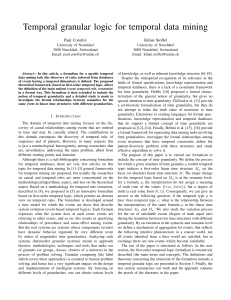

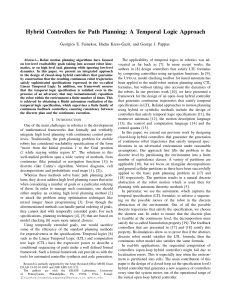
![[www.georgejpappas.org]](http://s1.studylibfr.com/store/data/009043713_1-9dcc0105dcc10c0174e78cd4e36229e2-300x300.png)
